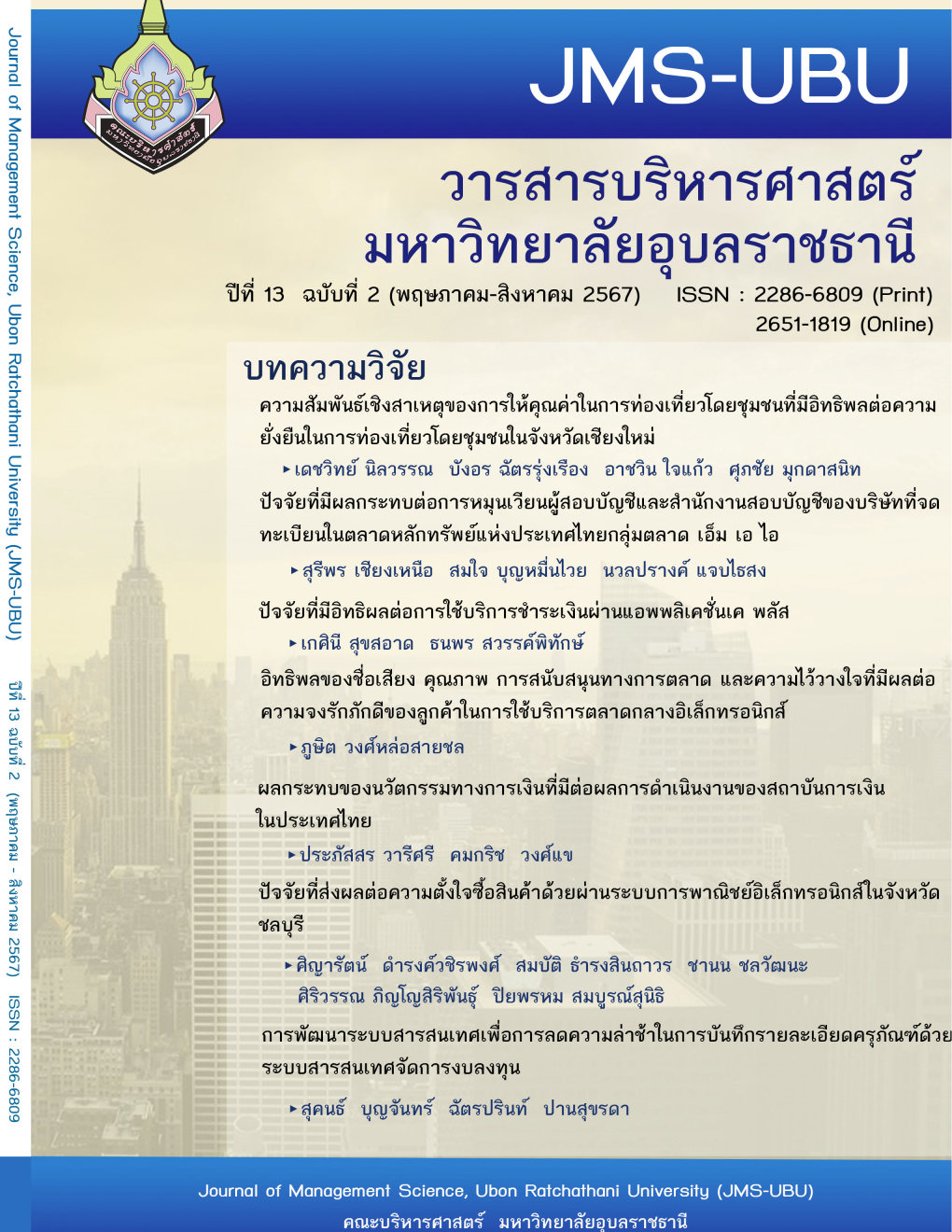ความสัมพันธ์เชิงสาเหตุของการให้คุณค่าในการท่องเที่ยวโดยชุมชนที่มีอิทธิพลต่อความยั่งยืนในการท่องเที่ยวโดยชุมชนในจังหวัดเชียงใหม่
Main Article Content
บทคัดย่อ
งานวิจัยนี้มีวัตถุประสงค์เพื่อศึกษาความสัมพันธ์เชิงสาเหตุระหว่างปัจจัยของการให้คุณค่าในการท่องเที่ยวโดยชุมชนที่มีอิทธิพลต่อความยั่งยืนในการท่องเที่ยวโดยชุมชนในจังหวัดเชียงใหม่ ประชากรและกลุ่มตัวอย่าง ได้แก่ นักท่องเที่ยวในจังหวัดเชียงใหม่ โดยใช้การสุ่มตัวอย่าง จำนวน 400 คน เครื่องมือที่ใช้ในการวิจัย ได้แก่ แบบสอบถาม สถิติที่ใช้วิเคราะห์ข้อมูล คือ ค่าเฉลี่ย ส่วนเบี่ยงเบนมาตรฐาน และเทคนิคการวิเคราะห์ความสัมพันธ์เชิงสาเหตุ ผลการวิจัย พบว่า ปัจจัยของการให้คุณค่าในการท่องเที่ยวโดยชุมชนที่มีอิทธิพลต่อความยั่งยืนในการท่องเที่ยวโดยชุมชนในจังหวัดเชียงใหม่ ตัวแปรที่มีอิทธิพลเชิงบวก ได้แก่ ปัจจัยด้านการเติบโตทางเศรษฐกิจ ปัจจัยด้านมานุษยวิทยา ปัจจัยด้านการอนุรักษ์ธรรมชาติ ปัจจัยด้านคุณค่าทางสังคม และปัจจัยด้านการพัฒนาชุมชนในท้องถิ่น โดยปัจจัยด้านการเติบโตทางเศรษฐกิจมีอิทธิพลมากที่สุดต่อความยั่งยืนในการท่องเที่ยวโดยชุมชนในจังหวัดเชียงใหม่ อย่างไรก็ตามยังพบว่ามีตัวแปรที่มีอิทธิพลเชิงลบ ได้แก่ ปัจจัยด้านนิเวศนิยมและปัจจัยด้านนักท่องเที่ยว แสดงให้เห็นว่าความยั่งยืนในการท่องเที่ยวโดยชุมชนในจังหวัดเชียงใหม่ต้องพึงพาการเติบโตทางเศรษฐกิจ ขณะเดียวกันก็ต้องให้ความสำคัญกับการสร้างจิตสำนึกในการดูแลรักษาสิ่งแวดล้อมควบคู่กับประสบการณ์การเรียนรู้วิถีชีวิตความเป็นอยู่แบบคนท้องถิ่น และคุณค่าทางสังคมของชุมชนท้องถิ่น ซึ่งปัจจัยเหล่านี้ล้วนเป็นหัวใจสำคัญของการท่องเที่ยวโดยชุมชนที่ยั่งยืน
Downloads
Article Details

อนุญาตภายใต้เงื่อนไข Creative Commons Attribution-NonCommercial-NoDerivatives 4.0 International License.
เอกสารอ้างอิง
กนกกานต์ แก้วนุช. (2563). ปัจจัยในการออกแบบรายการนำเที่ยวโดยชุมชนเชิงสร้างสรรค์. วารสารการจัดการ มหาวิทยาลัยวลัยลักษณ์, 8(2), 49-59.
กมลกนก เกียรติศักดิ์ชัย, ศริญา ประเสริฐสุด และเธียรรัตน์ ฉัตรภัทรพล. (2562). การสังเคราะห์การท่องเที่ยวโดยชุมชน: โอกาสหรืออุปสรรคต่อการพัฒนาแบบยั่งยืน. วารสารศรีปทุมปริทัศน์ ฉบับมนุษยศาสตร์และสังคมศาสตร์, 19(2), 177-190.
กรมการท่องเที่ยว. (2557). คู่มือการตรวจประเมินมาตรฐานคุณภาพแหล่งท่องเที่ยวเชิงนิเวศ. กรุงเทพฯ: สำนักพัฒนาบริการท่องเที่ยว.
กระทรวงการท่องเที่ยวและกีฬา. (2566). รายงานภาวะเศรษฐกิจการท่องเที่ยว ปีที่ 3 ฉบับที่ 2/2565. สืบค้นเมื่อ 20 กุมภาพันธ์ 2566, จาก https://www.mots.go.th/news/category/700
กระทรวงการท่องเที่ยวและกีฬา. (2566). สรุปสถานการณ์พักแรม จำนวนผู้เยี่ยมเยือน และรายได้จากผู้เยี่ยมเยือน เดือนธันวาคม 2565. สืบค้นเมื่อ 20 กุมภาพันธ์ 2566, จาก https://www.mots.go.th/news/category/657
กรุงเทพธุรกิจ. (2566). “ททท.” คงเป้ารายได้รวมท่องเที่ยวปี 66 เท่าเดิม 2.38 ล้านล้านบาท. สืบค้นเมื่อ 13 กุมภาพันธ์ 2566, จาก https://www.bangkokbiznews.com/business/business/1052775
การท่องเที่ยวแห่งประเทศไทย. (2561). การท่องเที่ยวโดยชุมชนวิถีไทยเก๋ไก๋อย่างยั่งยืน. สืบค้นเมื่อ 20 กุมภาพันธ์ 2566, จาก https://tatreviewmagazine.com/e_magazine/vol-4-no-3-july-september-2018-3/
การท่องเที่ยวแห่งประเทศไทย. (2561). ลบภาพจำนักท่องเที่ยวชาวเยอรมนีปรับตลาดสู่คุณภาพผ่าน Local Experience. สืบค้นเมื่อ 20 กุมภาพันธ์ 2566, จาก https://tatreviewmagazine.com/e_magazine/vol-4-no-1-january-march-2018/
จิตรลดา ปิ่นทอง. (2564). ผลกระทบของการพัฒนาการท่องเที่ยวที่มีต่อวิถีชีวิตของคนในชุมชนจังหวัดจันทบุรี. วารสารวิจัยและพัฒนา มหาวิทยาลัยราชภัฏเลย, 58(4), 34-45.
จุฑารัตน์ หนูสุวรรณ. (2561). การท่องเที่ยวเชิงนิเวศในภูมิภาคตะวันออกของประเทศไทย. วารสารเศรษฐศาสตร์และกลยุทธ์การจัดการ. 5(2), 87-110.
ชูศรี วงศ์รัตนะ. (2553). เทคนิคการใช้สถิติเพื่อการวิจัย (พิมพ์ครั้งที่ 12). กรุงเทพฯ: ไทเนรมิตกิจอินเตอร์โปรเกรสซิฟ.
ดรรชนี เอมพันธุ์. (2550). การพัฒนาการท่องเที่ยวโดยชุมชนและการจัดกิจกรรมโฮมสเตย์. กรุงเทพฯ: สำนักพิมพ์มหาวิทยาลัยเกษตรศาสตร์.
บุญเลิศ จิตตั้งวัฒนา. (2542). การวางแผนการพัฒนาการท่องเที่ยวแบบยั่งยืน. (รายงานผลการวิจัย). เชียงใหม่: มหาวิทยาลัยเชียงใหม่, คณะมนุษยศาสตร์.
ประชิต สกุณะพัฒน์, วิมล จิโรจพันธุ์ และอุดม เชยกีวงศ์. (2554). การท่องเที่ยวเชิงนิเวศ. กรุงเทพมหานคร: สำนักพิมพ์แสงดาว.
ปาริฉัตร ศรีหะรัญ และพรพิมล ขำเพชร. (2561). การท่องเที่ยวโดยชุมชน: ทางเลือกใหม่สู่ความยั่งยืน. วารสารวิทยาลัยดุสิตธานี. 12(3), 118-132.
พจนา สวนศรี และ สมภพ ยี่จอหอ. (2556). คู่มือมาตรฐานการท่องเที่ยวโดยชุมชน. เชียงใหม่: มหาวิทยาลัยพายัพ, สถาบันการท่องเที่ยวโดยชุมชน.
พิมพ์ลภัส พงศกรรังศิลป์. (2557). การจัดการการท่องเที่ยวชุมชนอย่างยั่งยืน: กรณีศึกษาบ้านโคกไคร จังหวัดพังงา. วารสารวิชาการ Veridian E-Journal ฉบับมนุษยศาสตร์ สังคมศาสตร์ และศิลปะ, 7(3), 650-665.
ยุทธ์ ไกยวรรณ์. (2556). การวิเคราะห์สถิติสำหรับงานวิจัยหลายตัวแปร. (พิมพ์ครั้งที่ 1). กรุงเทพฯ: จุฬาลงกรณ์มหาวิทยาลัย.
วรรณวิมล ภู่นาค. (2558). ศักยภาพชุมชนในการจัดการท่องเที่ยวโดยชุมชน: กรณีศึกษาตลาดน้ำอัมพวา. วารสารวิทยบริการ มหาวิทยาลัยสงขลานครินทร์, 26(1), 63-74.
วีระพล ทองมา. (2559). การท่องเที่ยวโดยชุมชน (Community Based Tourism :CBT) สำหรับการพัฒนาคุณภาพชีวิตของชุมชนในเขตที่ดินป่าไม้. สืบค้นเมื่อ 20 กุมภาพันธ์ 2566, จาก www.dnp.go.th/fca16/file/i49xy4ghqzsh3j1.doc
ศูนย์วิจัยกสิกรไทย. (2565). Current Issue 28.3370/ 9 ธันวาคม 2565. สืบค้นเมื่อ 20 กุมภาพันธ์ 2566, จาก https://portal.settrade.com/brokerpage/IPO/Research/upload/2000000452066/3370_p.pdf
สำนักงานการท่องเที่ยวและกีฬาจังหวัดเชียงใหม่. (2564). แผนที่เส้นทางท่องเที่ยวโดยชุมชนจังหวัดเชียงใหม่. สืบค้นเมื่อ 20 กุมภาพันธ์ 2566 จาก https://issuu.com/jett_jj/docs/chiangmai_route_ebook
สำนักงานสภาพัฒนาการเศรษฐกิจและสังคมแห่งชาติ. (2566). ภาวะเศรษฐกิจไทยไตรมาสที่สี่ ทั้งปี 2565 และแนวโน้มปี 2566. สืบค้นเมื่อ 20 กุมภาพันธ์ 2566, จาก https://www.nesdc.go.th/ewt_dl_link.php?nid=13445
สุดถนอม ตันเจริญ. (2561). การจัดการการท่องเที่ยวโดยชุมชนกับการพัฒนาการท่องเที่ยวอย่างยั่งยืนของชุมชนบางขันแตก จังหวัดสมุทรสงคราม. วารสารวิชาการมหาวิทยาลัยราชภัฏเพชรบุรี, 8(2), 32-41.
องค์การบริหารการพัฒนาพื้นที่พิเศษเพื่อการท่องเที่ยวอย่างยั่งยืน. (2559). การท่องเที่ยวอย่างยั่งยืน. กรุงเทพฯ: สำนักบริหารยุทธศาสตร์ องค์การบริหารพัฒนาพื้นที่พิเศษเพื่อการท่องเที่ยวอย่างยั่งยืน.
Ali, F., Kim, W., Li, J., & Jeon, H. (2018). Make it delightful: Customers’ experience, satisfaction and loyalty in Malaysian theme parks. Journal of Destination Marketing and Management. 7, 1-11.
Almeida-García, F., Peláez-Fernández, M. Á., Balbuena-Vázquez, A., & Cortés-Macias, R. (2016). Residents' perceptions of tourism development in Benalmádena (Spain). Tourism Management, 54, 259-274.
Cochran, W. G. (1953). Sampling Techniques. New York: John Wiley & Sons.
Cronbach, L. J. (1970). Essentials of Psychology Testing (5th ed.). New York: Harper Collin.
Denman, R. (2001). Guidelines for Community Based Ecotourism Development. Washington: McGraw-Hill.
Grilli, G., Tyllianakis, E., Luisetti, T., Ferrini, S., & Turner, R. K. (2021). Prospective tourist preferences for sustainable tourism development in Small Island Developing States. Tourism Management, 82, DOI: 10.1016/j.tourman.2020.104178
Hou, J. S., Lin, C. H., & Morais, D. B. (2005). Antecedents of attachment to a cultural tourism destination: The case of Hakka and non-Hakka Taiwanese visitors to Pei-Pu, Taiwan. Journal of Travel Research, 44(2), 221-233.
Hunter, C. (1997). Sustainable tourism as an adaptive paradigm. Annals of Tourism Research, 24(4), 850- 867.
Kim, J. H. (2014). The antecedents of memorable tourism experiences: The development of a scale to measure the destination attributes associated with memorable experiences. Tourism Management, 44, 34-45.
Lee, T. H. (2009). A structural model for examining how destination image and interpretation service affect future visitation behavior: A case study of Taiwan's Taomi eco-village. Journal of Sustainable Tourism, 17(6), 727-745.
Likert, R. (1932). A technique for the measurement of attitudes. Archives of Psychology, 140, 5-55.
Lucchetti, V. G., & Font, X. (2013). Community based tourism: Critical success factors (ICRT occasional paper). N.P.: The International Centre for Responsible Tourism.
Mayo, M., & Craig, G. (1995). Community Empowerment: A Reader in Participation and Development. London: Zed Books.
Murphy, P. E. (1985). Tourism: A Community Approach. London, UK: Routledge.
Navrud, S. & Strand, J. (2018). Valuing global ecosystem services: What do European experts say? Applying the delphi method to contingent valuation of the amazon rainforest. Environmental and Resource Economics, 70(1), 249-269.
Poria, Y., Reichel, A., & Brian, A. (2006). Heritage site management: motivations and expectations. Annals of Tourism Research, 33(1), 162-178.
Preston, J. P. (2013). Community Involvement in School: Social Relationships in a Bedroom Community. Canadian Journal of Education, 36(3), 413 - 437.
Richards, G., & Wilson, J. (2006). Developing creativity in tourist experiences: A solution to the serial reproduction of culture? Tourism Management, 27(6), 1209–1223.
Richards, G. (2002). Tourism attraction systems: exploring cultural behavior. Annals of Tourism Research, 29(4), 1048-1064.
Sharpley, R., & Sundaram, P. (2005). Tourism: a sacred journey? The case of ashram tourism, India. International Journal of Tourism Research, 7(3), 161-171.
Tung, V. W. S., & Ritchie, J. R. B. (2011). Exploring the essence of memorable tourism experiences. Annals of Tourism Research, 38(4), 1367-1386.
Yoon, Y., Gursoy, D., & Chen, J. S. (2001). Validating a tourism development theory with structural equation modeling. Tourism Management, 22(4), 363–372.

